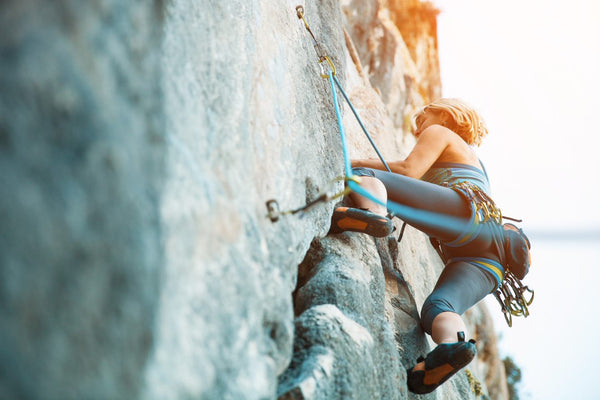
How to Pick the Best Rock Climbing Shoes for You

With so many options on the market, picking the right climbing shoe can be a daunting task. Luckily for you, Ascent Outdoors is here to break down the basics when it comes to finding your perfect fit.
There are several things to consider when picking a climbing shoe, but the most important factors to focus on are fit, shoe type and what style of climbing you’ll be doing.
Fit:
Climbing shoes are personal and everyone is going to have a preference based on their foot, but a comfortable fit is key, especially if you’re a beginner. Your shoes should be snug, but not painful. Chances are you’re not a prima ballerina and there’s no need for your feet to suffer. Your shoes will change as you advance in your climbing experience and you may begin to opt for shoes that bend your toes and contort your foot differently for maximum performance, but regardless of skill level, your shoes should feel like a nice firm handshake rather than a death grip. There should be enough room in the toes that you can wiggle them a bit with no dead space and the heel should fit snug enough that you can’t pull them off too easily while not digging into your Achilles tendon.
The material of the shoe is important and will impact the fit. Shoes with a leather or suede body, also known as the upper, can stretch up to a full size and will mold to the width of your foot while shoes with a synthetic upper will not change much and will maintain their stiffness. Something else to keep in mind is that the rubber of the sole will not stretch, so make sure the shoes you pick are long enough the first time you try them on.
It is strongly advised to try climbing shoes on before purchasing, especially if you’re getting your first pair or a new style. There is no universal sizing for climbing shoes and fit can vary from brand to brand. Try on different styles and ignore the intended gender of the shoe. If you have a narrow foot and high arch, shoes designed for women or low volume (LV) styles may be better suited for you. On the flip side, if you have a wider foot and need more room for your toes, browse styles intended for men. No matter what you choose, you’ll want to wear the shoes for a bit and meet them in person to make sure they’re what you’re looking for.
Shoe Type and Climbing Style:
Climbing shoes can be broken down into three categories: neutral, moderate and aggressive. The type can be identified by the curve and edges of the shoe. Neutral is the flattest, moderate shoes have a slightly downturned shape and aggressive shoes come to a sharp and curved point at the big toe.
Neutral:
A neutral style can be identified by a symmetrical shape with a smooth toe box that allows your foot to lay flat in the shoe. Shoes with a neutral fit are the most comfortable and are best for beginners and climbers looking for a good shoe for long multi-pitch climbs or trad routes. Neutral shoes typically offer the stiffest and most long lasting rubber for optimal foot support, which makes them a perfect shoe for getting started or for shoving into cracks on alpine climbs.
Recommended: La Sportiva Mythos, Unparallel UP-MOCC
Moderate:
Moderate shoes are some of the most versatile and can take on climbing styles from short boulder problems to long sport climbs. Moderate shoes can be identified by a slight curve in the toe and a subtle arch that moves your foot into a slightly pointed position for more technical climbing. Thinner and stickier rubber means more sensitivity in your toes to feel those small holds and gives you the confidence of being sure-footed. Moderate styles are a great stop for intermediate climbers before graduating to more hard core shoes.
Recommended: La Sportiva Miura, Scarpa Vapor
Aggressive:
These are the hard core shoes as previously mentioned. Aggressive shoes are designed primarily for short, steep and hard climbs. They’re notorious for being unpleasant to wear, but what you sacrifice in comfortability you’ll make up for in performance.The style is characterized by an asymmetrical shape and sharp curve in the arch and toe box of the shoe that aims to keep your foot in a strong position for precision on challenging routes. You’ll definitely want to take this style off and stretch your feet in between climbs, but the payoff is worth it for climbers venturing into overhung territory.
Recommended: La Sportiva Katana Lace, Scarpa Instinct VS
Other tips:
- Don’t wear socks: people may wear socks outside on especially cold crag days, but climbing shoes are designed to just hold your bare foot.
- Try shoes on in the afternoon: your feet swell as the day goes on. For optimal fit, try climbing shoes on later in the day to make sure you’re getting the right fit.
- Give it time: you should be able to keep your shoes on for at least 30 minutes. If that’s not happening, bump up a size.

